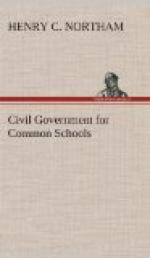1856. George W. Clinton ....... Buffalo. 1858. Lorenzo Burrows ......... Albion. 1859. Robert S. Hale ..... Elizabethtown. 1861. Elias W. Leavenworth .... Syracuse. 1861. J. Carson Brevoort ...... Brooklyn. 1864. Geo. Wm. Curtis, W. New Brighton. 1870. Francis Kernan .......... Utica. 1871. John L. Lewis ........... Penn Yan. 1872. Henry R. Pierson ........ Albany. 1873. Martin I. Townsend .......... Troy. 1874. Anson J. Upson ........... Auburn. 1876. Wm. L. Bostwick ......... Ithaca. 1877. Orris H. Warren ....... Syracuse. 1877. Chauncey M. Depew ...... New York. 1877. Charles E. Fitch ....... Rochester. 1878. Whitelaw Reid ........ New York. 1878. Leslie W. Russell ....... Canton. 1881. Wm. H. Watson ............. Utica. 1881. Henry E. Turner ......... Lowville.
Officers of the board.
Henry R. Pierson, Chancellor. George W. Clinton,
Vice-Chancellor.
David Murray, Secretary. Daniel J. Pratt, Assistant
Secretary.
IX.—JUDICIARY.
A tabular view of the judiciary of the State, commencing with the lowest courts and showing them in their regular order, leaving out such as are established for particular localities.
I. Justice Court
II. County Court.
1. County Court
2. Sessions.
III. Supreme
1. Circuit.
2. Oyer and Terminer.
3. Special Term.
4. General Term.
IV. Court of Appeals.
Justice court.
Q. What is the lowest court in the State?
A. A Justice’s Court, held in each town by one of the justices of the Peace.
Q. What jurisdiction has this court?
A. Original; that is, suits can be commenced in it, and tried in it.
Q. In a civil action how large a judgment can be obtained?
A. Not to exceed two hundred dollars.
Q. Can criminal suits be tried in a Justice Court?
A. Some can be tried in it; but usually the parties give bail for their appearance at a higher court to await the action of the Grand Jury.
County court.
Q. What is the next higher court?
A. The County Court.
Q. What are the divisions of the County Court?
A. County Court and Court of Sessions.
Q. For what causes are each designed?
A. The County Court is for the trial of civil causes, the Sessions for the trial of criminal causes, but not of the higher crimes.
Q. What jurisdiction has the County Court?
A. Original and Appellate, that is a suit may be commenced in it, or it may be appealed from a lower court.
Q. What jurisdiction has the Court of Sessions?
A. Original; no person can be tried in it, who is charged with a crime until he is indicted by a Grand Jury.




